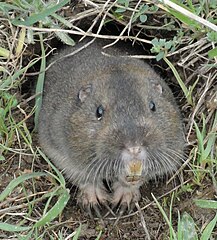Bobrokształtne
podrząd gryzoni
(Przekierowano z Castorimorpha)
Bobrokształtne[4] (Castorimorphi) – infrarząd[3][5] ssaków z podrzędu Supramyomorpha w rzędzie gryzoni (Rodentia).
| Castorimorphi | |||
| A.E. Wood, 1955[1] | |||
 Przedstawiciel infrarzędu – goffernik brunatny (Thomomys bottae) | |||
| Systematyka | |||
| Domena | |||
|---|---|---|---|
| Królestwo | |||
| Typ | |||
| Gromada | |||
| Podgromada | |||
| Rząd | |||
| Podrząd | |||
| Infrarząd |
bobrokształtne | ||
| Synonimy | |||
|
| |||
| Rodziny | |||
| |||
Systematyka edytuj
Do infrarzędu Castorimorphi należą następujące występujące współcześnie rodziny[6][5][3][4]:
- Castoridae Hemprich, 1820 – bobrowate
- Heteromyidae J.E. Gray, 1868 – karłomyszowate
- Geomyidae Bonaparte, 1845 – gofferowate
Opisano również rodziny wymarłe[7]:
- Eomyidae Winge, 1887
- Eutypomyidae G.S. Miller & Gidley, 1918
- Florentiamyidae A.E. Wood, 1936
- Heliscomyidae Korth, Wahlert & Emry, 1991
- Jimomyidae Flynn, Lindsay & Martin, 2007
- Pipestoneomyidae Korth & Emry, 2013
- Rhizospalacidae Thaler, 1966
Rodzaje wymarłe o niepewnej pozycji systematycznej i nie przypisane do żadnej z rodzin[7]:
- Caribeomys Marivaux, Vélez-Juarbe, Viñola López, Fabre, Pujos, Santos-Mercado, Cruz, Grajales Pérez, Padilla, Vélez-Rosado, Cornée, Philippon, Münch & Antoine, 2021[8] – jedynym przedstawicielem był Caribeomys merzeraudi Marivaux, Vélez-Juarbe, Viñola López, Fabre, Pujos, Santos-Mercado, Cruz, Grajales Pérez, Padilla, Vélez-Rosado, Cornée, Philippon, Münch & Antoine, 2021
- Dikkomys Wood, 1936[9] – jedynym przedstawicielem był Dikkomys matthewi A.E. Wood, 1936
- Floresomys Fries, Hibbard & Dunkle, 1955[10] – jedynym przedstawicielem był Floresomys guanajuatoensis Fries, Hibbard & Dunkle, 1955
- Griphomys R.E. Wilson, 1940[11]
- Harrymys Munthe, 1988[12]
- Hydentomys Tong Yongsheng, 1997[13]
- Lignimus Storer, 1970[14]
- Meliakrouniomys Harris & Wood, 1969[15]
- Mojavemys Lindsay, 1972[16]
- Phelosaccomys Korth & Reynolds, 1994[17]
- Proharrymys Korth & Branciforte, 2007[18]
- Tenudomys Rensberger, 1973[19]
Przypisy edytuj
- ↑ A.E. Wood. A revised classification of the rodents. „Journal of Mammalogy”. 36 (2), s. 175, 1955. DOI: 10.2307/1375874. (ang.).
- ↑ J.V. Carus: Handbuch der Zoologie. Cz. 1: Wirbelthiere, Mollusken und Molluscoiden. Leipzig: Wilhelm Engelmann, 1868, s. 99. (niem.).
- ↑ a b c G. D’Elía, P.-H. Fabre & E.P. Lessa. Rodent systematics in an age of discovery: Recent advances and prospects. „Journal of Mammalogy”. 100 (3), s. 852–871, 2019. DOI: 10.1093/jmammal/gyy179. (ang.).
- ↑ a b Nazwy polskie za: W. Cichocki, A. Ważna, J. Cichocki, E. Rajska-Jurgiel, A. Jasiński & W. Bogdanowicz: Polskie nazewnictwo ssaków świata. Warszawa: Muzeum i Instytut Zoologii PAN, 2015, s. 192–297. ISBN 978-83-88147-15-9. (pol. • ang.).
- ↑ a b C.J. Burgin, D.E. Wilson, R.A. Mittermeier, A.B. Rylands, T.E. Lacher & W. Sechrest: Illustrated Checklist of the Mammals of the World. Cz. 1: Monotremata to Rodentia. Barcelona: Lynx Edicions, 2020, s. 26. ISBN 978-84-16728-34-3. (ang.).
- ↑ N. Upham, C. Burgin, J. Widness, M. Becker, C. Parker, S. Liphardt, I. Rochon & D. Huckaby: Treeview of Mammalian Taxonomy Hierarchy. [w:] ASM Mammal Diversity Database (Version 1.11) [on-line]. American Society of Mammalogists. [dostęp 2023-09-28]. (ang.).
- ↑ a b J.S. Zijlstra, Castorimorphi, Hesperomys project (Version 23.8.1), DOI: 10.5281/zenodo.7654755 [dostęp 2023-09-28] (ang.).
- ↑ L. Marivaux, J. Vélez-Juarbe, L.W. Viñola López, P. Fabre, F. Pujos, H. Santos-Mercado, E.J. Cruz, A.M. Grajales Pérez, J. Padilla, K.I. Vélez-Rosado, J. Cornée, M. Philippon, P. Münch & P. Antoine. An unpredicted ancient colonization of the West Indies by North American rodents: dental evidence of a geomorph from the early Oligocene of Puerto Rico. „Papers in Palaeontology”. 7 (4), s. 2024, 2021. DOI: 10.1002/spp2.1388. (ang.).
- ↑ A.E. Wood. Geomyid rodents from the Middle Tertiary. „American Museum novitates”. 866, s. 26, 1936. (ang.).
- ↑ C. Fries, Jr., C.W. Hibbard & D.H. Dunkle. Early Cenozoic vertebrates in the red conglomerate at Guanajuato, Mexico. „Smithsonian miscellaneous collections”. 123 (7), s. 16, 1955. (ang.).
- ↑ R.W. Wilson. Two new Eocene rodents from California. „Carnegie Institution of Washington publication”. 514, s. 93, 1940. (ang.).
- ↑ J. Munthe. Miocene mammals of the Split Rock area, Granite Mountains Basin, central Wyoming. „University of California publications in geological sciences”. 126, s. 67, 1988. (ang.).
- ↑ Y.-s. Tong. Middle Eocene small mammals from Liguanqiao basin of Henan province and Yuanqu basin of Shanxi province, Central China. „Palaeontologica Sinica”. New Series C. 18 (26), s. 145, 1997.
- ↑ J.E. Storer. New rodents and lagomorphs from the Upper Miocene Wood Mountain Formation of southern Saskatchewan. „Canadian Journal of Earth Sciences”. 7 (4), s. 1127, 1970. DOI: 10.1139/e70-106. (ang.).
- ↑ J.M. Harris & A.E. Wood. A new genus of eomyid rodent from the Oligocene Ash Spring local fauna of Trans-Pecos Texas. „Pearce-Sellards Series”. 14, s. 3, 1969. (ang.).
- ↑ E.H. Lindsay. Small mammal fossils from the Barstow Formation, California. „University of California publications in geological sciences”. 93, s. 59, 1972. (ang.).
- ↑ W.W. Korth & R.E. Reynolds. A hypsodont gopher (Rodentia, Geomyidae) from the Clarendonian (Miocene) of California. „San Bernardino County Museum Association Special Publication”. 94-1, s. 91, 1994. (ang.).
- ↑ W.W. Korth & C. Branciforte. Geomyoid rodents (Mammalia) from the Ridgeview Local Fauna, Early-Early Arikareean (Late Oligocene) of western Nebraska. „Annals of Carnegie Museum”. 76 (3), s. 194, 2007. DOI: 10.2992/0097-4463(2007)76[177:GRMFTR]2.0.CO;2. (ang.).
- ↑ J.M. Rensberger. Pleurolicine rodents (Geomyoidea) of the John Day Formation, Oregon, and their relationships to taxa from the Early and Middle Miocene, South Dakota. „University of California publications in geological sciences”. 102, s. 78, 1973. (ang.).